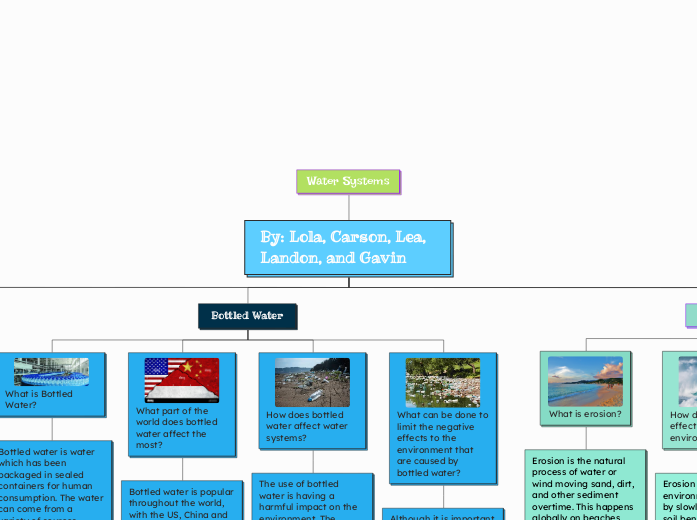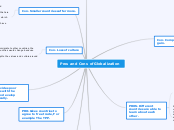Water Systems
By: Lola, Carson, Lea, Landon, and Gavin
THANKS FOR LISTENINNG!!
Dams
What can be done to limit the negative affects to the environment?
Dams have reduced fisheries, degraded river ecosystems, and altered recreational opportunities.
How do dams affect water systems?
Slow moving, or stopped reservoirs can heat up, ending up in abnormal temperature fluctuations which can affect sensitive species.
Are Dams Local, national or global?
Dams are global because, they don't just have a local environment impact, but it's clear they play a role in global carbon cycle.
What are Dams?
Dams are barriers that restrict or stop water flow. Dams are also a man made activity.
Erosion
How does erosion affect the water system, and how can we limit the negative effects?
Erosion can affect the water systems by dragging trash, pollution and potentially infected or bad water into other bodies of water, this can cause locally polluted water to become nationally polluted water and eventually globally polluted water. Things we can do to limit these effects include re-vegetating areas that have a lack of plants to protect the soil from wind and rainfall.
How does erosion effect the environment?
Erosion effects the environment every day by slowly moving the soil beneath our feet. In the past 150 years, erosion has lost half of the world's topsoil due to poor farming practices like over-grazing and improper tilling or chopping down vegetation.
What is erosion?
Erosion is the natural process of water or wind moving sand, dirt, and other sediment overtime. This happens globally on beaches, rivers and every moving body of water. This means that the soil below your feet is ever-changing.
Bottled Water
What can be done to limit the negative effects to the environment that are caused by bottled water?
Although it is important to always recycle plastic bottles, the best strategy to reduce our ecological footprint is to avoid purchasing them by bringing your own reusable bottles, or to reduce the amount of plastic water bottles purchased whenever possible.
How does bottled water affect water systems?
The use of bottled water is having a harmful impact on the environment. The amount of water used for bottling can add up to millions and millions of litres in Canada every year, which can lead to reduced water tables. These lower water tables can affect local ecosystems and environments. Plastic can also leach toxic chemicals, affecting animals that ingest it, contaminating the animal and human food chains.
What part of the world does bottled water affect the most?
Bottled water is popular throughout the world, with the US, China and Indonesia the largest consumers. Collectively accounting for nearly 40% of the global bottled water volume. Bottled water is a global issue, transporting bottled water to market produces air pollution and emissions of carbon dioxide which contribute to global warming.
What is Bottled Water?
Bottled water is water which has been packaged in sealed containers for human consumption. The water can come from a variety of sources including springs, aquifers, or municipal supplies and may be treated to make it fit for human consumption. It is caused by human activity, because humans make the bottled water in its bottles.
Rainfall Changes
What Can we do to limit negative effects on Rainfall Changes
Things that we can do to limit negative effects on rainfall changes is to carefully manage natural drainage systems and to conserve water.
How do Rainfall Changes Affect Living Things
Rainfall Changes affect living things by destroying natural habitats and animals homes. This causes the animals to find a new home but can sometimes lead to death.
What part of the world does Rainfall Changes affect?
Rainfall changes mostly affect places that are closest to the equator due to the heat. Rainfall changes are global and affect the whole world. Colder areas do not get rainfall changes as much and is pretty rare. The reason why it does not hit cold ares is because there are no bodies of water.
What is Rainfall Changes?
Rainfall changes are when a storm has increased or decreased from a specific area. Rainfall changes are terrible for the earth and floods the whole earth and takes a long time for the water to evaporate.
Irrigation
How does irrigation effect water systems?
If you do too much irrigation, it can cause contaminates to enter the watercourse or aquifers by leaching through the soil and overland runoff. Heavy soils are more likely to runoff if the irrigation system applies water at a greater rate than the applied water can infiltrate the soil. Too much irrigation may also cause dissolved nutrients to move through the soil to a place where plants can no longer reach the nutrients.
What can be done to limit the negative effects that are caused by irrigation?
We can limit the effects by selecting systems that are not as susceptible to evaporation. Using sprinklers can also reduce water use by 5-15%, especially in windy areas. Using a drip system can reduce water use up to 20%.
How Does Irrigation effect the environment?
Irrigation effects the environment globally because soil can be over-irrigated due to poor distribution. Irrigation wastes water, chemicals, and may lead to water pollution. The 2 continents of irrigation effects the most are Asia, South America
What is irrigation?
Irrigation is to water crops by bringing in water from pipes, canals, sprinklers, or other man-made means, rather than relying on rainfall alone. Places that rely on Natural Rainfall Could not sustain agriculture without irrigation. Irrigation is human activity.









